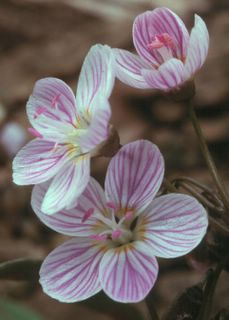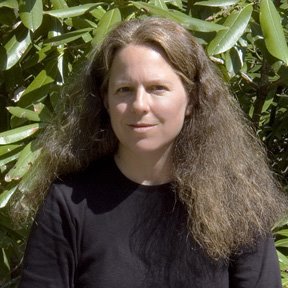Spring Beauty Flowers

Spring Beauty, April 4, 1996
The spring beauty flower has 5 petals. Each petal has pink veins that can range from very pale to very bright. The leaves, usually in pairs, are long and thin--the shape of grass blades, but thicker and more succulent. The leaves feel cool and rubbery to the touch (except in the sun, and then they feel warm).
In forests that have been spared grazing, plowing, and clear-cutting, spring beauty can form an amazing thick pink carpet across the forest floor! However, most forests have only occassional patches that are NOTHING like the original carpets that used to fill the eastern forests of the United States. A few "wall to wall" carpets remain, and if you find one, count yourself lucky!
This photo, a scanned negative, was taken using my old Cannon AE-1 with 50 mm macro lens, and a life-size converter that has the effect of turning this into a 100 mm lens. There isn't much working distance, however, so I had to get really close! This is unfortunately one of my best photos of spring beauty so far. I plan to remedy this "problem" in spring 2006.
This photo was taken near peak blooming time in a forest of eastern Iowa. During peak blooming time, you can sometimes find 3 or 4 flowers in bloom on a single stem, when usually you would find only 1 or 2. Flowers bloom in a predictable sequence, starting at the bottom of the stem and working their way toward the top.
I like this photograph because it shows the different stages of the spring beauty flower. During the first day that the flower is open, it is in the "male" stage (see top flower). Its five stamen, covered with bright pink pollen, stand tall in the middle of the flower. Any bees that visit will surely take some of this pollen with them as they fly off to another flower. On the second day, the stamen have moved toward the outer edges of the flower, and the flower enters its "female" stage (see middle flower). At this time, the stigma (in the center of the flower) opens so that it can receive pollen brought by the bees. Once pollinated, the flower will close up rather quickly, its petals will shrivel up, and eventually anywhere from 1 to 6 seeds will develop. If the flower is not pollinated on its first day open, it will likely open again in the female stage the next day (see bottom flower) for another try at pollination.
Weather can interefere with this process, however. For example, suppose the weather is cold and/or cloudy and/or rainy on its second day. Though the flower is "supposed" to be a female that day, it may not open at all. If the weather is warm and sunny the third day, that same flower may open as a female, but it may have lost its chance. So much depends on the weather.
As for bees, well, they also play a role in determining the plant's reproductive success. Early in the year, when it's cold, there are very few bees. However some flies, which resemble bees, and are often called "bee flies" do come out and start the process of pollinating some of the earliest flowers. As the weather gets warmer, bees become more common, and most flowers receive several visits from bees during the day. The early-blooming flowers often miss out on getting pollinated, and the later ones often don't have time to finish making their seeds before senescence sets in. But, since each plant produces an inflorescence with about 6 to 20 flowers, each plant usually makes dozens of seeds each year.
That is a brief introduction to spring beauty. Dare I say that I could write a whole thesis on this topic (and it would surely put you to sleep). But, forget data tables and graphs: I prefer to show pictures and tell the story!


0 Comments:
Post a Comment
<< Home